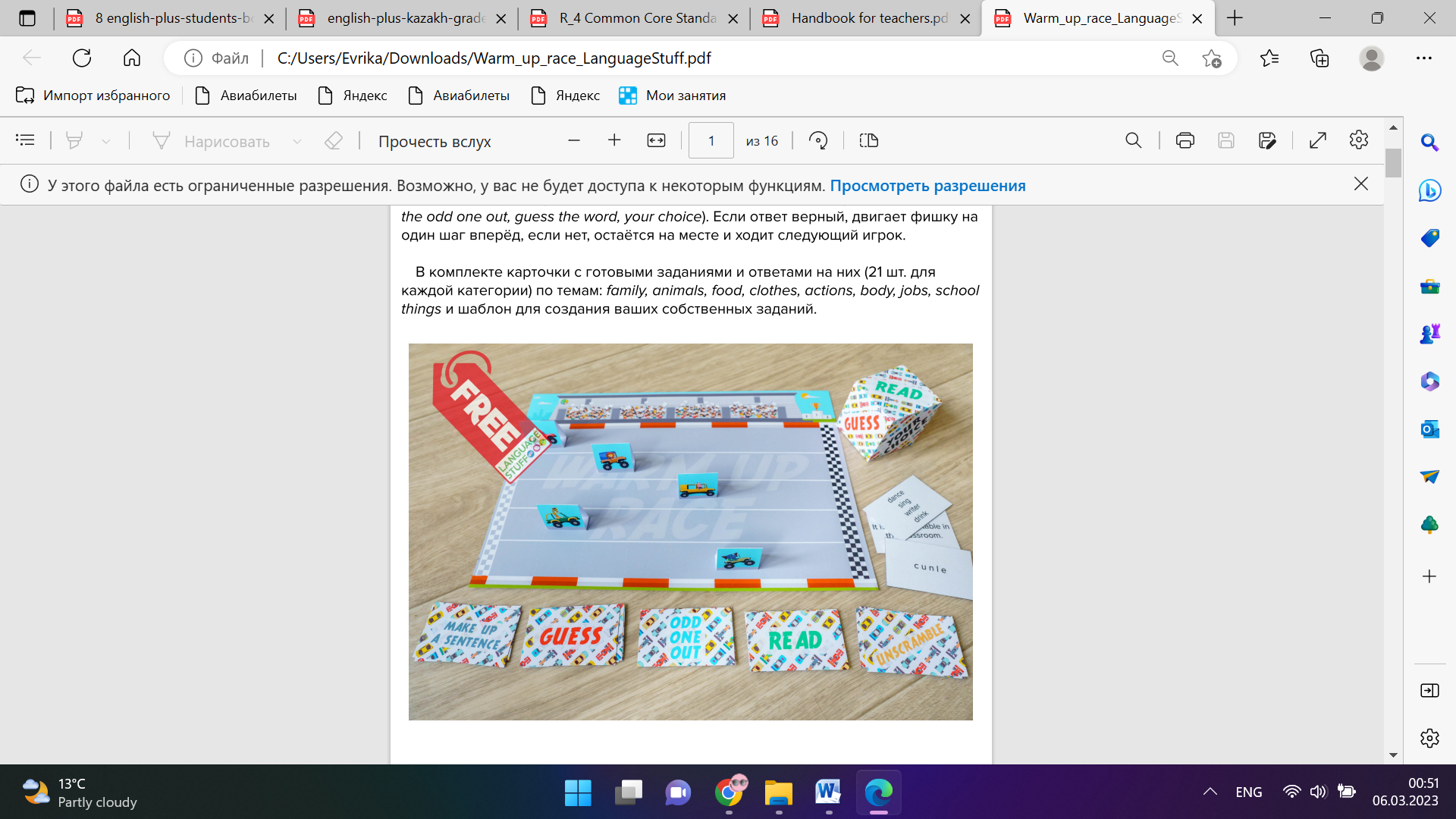
жүктеу мүмкіндігіне ие боласыз
Бұл материал сайт қолданушысы жариялаған. Материалдың ішінде жазылған барлық ақпаратқа жауапкершілікті жариялаған қолданушы жауап береді. Ұстаз тілегі тек ақпаратты таратуға қолдау көрсетеді. Егер материал сіздің авторлық құқығыңызды бұзған болса немесе басқа да себептермен сайттан өшіру керек деп ойласаңыз осында жазыңыз
ҚМЖ Eng Plus gr 5 term 4

Short term plan: term 4
|
Unit: 2 Sports |
Lesson 81 |
||
|
Teacher name: |
|
||
|
Date: |
|
||
|
Grade: 5 |
Number present: |
absent: |
|
|
Lesson title |
I can describe people, places, things |
||
|
Learning objectives |
5.2.2.1 understand an increasing range of unsupported basic questions which ask for personal information; 5.3.4.1 respond with limited flexibility at sentence level to unexpected comments on an increasing range of general and curricular topics; 5.6.2.1 use appropriate adjectives and indefinite article a / an including common noun phrases describing things and activities on a limited range of familiar general and curricular topics. |
||
|
Lesson objectives |
Learners will be able to: • Learn and practise basic adjectives. • Learn how to use a and an correctly. |
||
|
Value links |
Hospitality: Traditionally a nomadic culture, hospitality has always been an important part of Kazakh culture. |
||
|
Plan |
|||
|
Stages / Time |
Teachers’ actions |
Students’ actions |
Assessment criteria |
Resources |
|
Beginning of the lesson 5 min |
Organization moment 1.Greeting. Ask about the weather. The teacher sets the lesson objectives, letting students know what to anticipate from the lesson. Warm-up
Fasten your seat belts and get ready for the all-round race Lead – In • Books closed. Ask the class to think about their town or city. In pairs, students should think of three words to describe it, e.g. big, small, etc. Allow them about 1 minute for this. • Get feedback from the class and write their suggestions on the board. |
Students' attention is drawn to the lesson. Students discuss the pictures in pairs. Determines the topic and aim of the lesson Students say different words from the picture |
Formative Assessment
Good job! Assessment criteria - Recognize basic personal questions without support - Provide unprepared speech to answer a variety of questions at sentence level with limited flexibility |
Pictures Student’s book |
|
Middle of the lesson Presentation part. 35 min |
Ex: 1 P:12 • Write treasure hunt on the board and translate it into the students’ own language. Ask the class if they know what it is. Elicit that a treasure hunt is when people use clues to find treasure or a prize. Ask if any of the students have ever been on a treasure hunt and elicit any feedback they provide. • In a weaker class, look at the example carefully together. You might also like to do the second clue together as a class before they continue in their pairs. .Ex: 2 P:12 • Write big and small on the board. Ask the students how these adjectives are connected and elicit that they have opposite meanings. • Encourage students to identify pairs of opposites that are easier first so that they will have fewer adjectives to guess from if they do not know. Students do the task in pairs. • Play the recording to check their answers as a class. Ex: 4 P:12 • Focus students’ attention on the examples and the rules. • In a stronger class, ask students to go ahead and complete the rules based on the examples. • In a weaker class, read the rules together and work out the answers as a class. Ex: 5 P:12 • Students complete the activity individually, using the rules from exercise 4 to help them if necessary. • Ask fast finishers to make more short descriptions using other adjectives from exercise 1with a and an. Conclusion during the lesson some tasks differentiated by outcomes of the students and by their abilities. |
Students do the adjectives Treasure Hunts. Answers: A big poster Differentiation: «Verbal support» method is used to help Students use new words in the text. Students look at the adjectives in exercise 1 and find five pairs of adjectives. The listen and check. Answers: (terrible – great; popular – unpopular; boring – interesting; difficult – easy) Students complete the rules with a and an Answers: 1 an 2 a Students complete with a or an Answers: 1 an 2 a 3 a 4 an 5 an 6 a 7 an 8 a |
Descriptor: - work in pairs - find a secret objects Total: 1 point Descriptor: - identify pairs of opposites - listen and check. Total: 1 point Descriptor: - complete the sentences Total: 1 point Descriptor: -write sentences -complete with a or an Total: 1 point |
flashcards Worksheets |
|
End of the lesson 5 min |
FEEDBACK Learners provide feedback on what they have learned at the lesson. |
|
Students evaluate each other and encourage classmate with phrases like: Well done! Brilliant! Good job! I like it! . |
Poster
|
Short term plan: term 4
|
Unit: 2 Sports |
Lesson 82 |
||
|
Teacher name: |
|
||
|
Date: |
|
||
|
Grade: 5 |
Number present: |
absent: |
|
|
Lesson title |
A web page about clubs for young people |
||
|
Learning objectives |
5.2.4.1 understand the main points of supported extended talk on a range of general and curricular topics 5.4.1.1 understand the main points in a limited range of short simple texts on general and curricular topics 5.3.2.1 ask simple questions to get information about a limited range of general topics |
||
|
Lesson objectives |
Learners will be able to: • Read about people’s hobbies. • Practise giving opinions about different hobbies. • Learn the days of the week. |
||
|
Value links |
Tradition: Kazakh traditions and culture have been passed on from one generation to another through oral histories told by traditional Kazakh tribal leaders and elders. |
||
|
Plan |
|||
|
Stages / Time |
Teachers’ actions |
Students’ actions |
Assessment criteria |
Resources |
|
Beginning of the lesson 5 min |
Organization moment 1.Greeting. Ask about the weather. The teacher sets the lesson objectives, letting students know what to anticipate from the lesson. Warm-up
Fasten your seat belts and get ready for the all-round race Lead – In • Books closed. Mime a simple everyday hobby to the class, e.g. reading. Ask the class to tell you what you are doing. Elicit that you are reading and write reading on the board. • Do the same for three more hobbies, e.g. running, photography and listening to music. Write the activity on the board each time and model for pronunciation. |
Students' attention is drawn to the lesson. Students discuss the pictures in pairs. Determines the topic and aim of the lesson Students say different words from the picture |
Formative Assessment
Good job! Assessment criteria - Identify the main information of a talk using supporting information - Read and identify the main idea in the text. |
Pictures Student’s book |
|
Middle of the lesson Presentation part. 35 min |
Ex: 1 P:14 • Focus on the four pictures and draw students’ attention to the headings of the paragraphs. Ask them to give you the names of these clubs in their own language. • Go through the example and point out that I think (that) is one way in which we can give an opinion. • In pairs, students discuss the different clubs, giving their opinions. Remind them to use adjectives from pages 12 and 13. Get feedback from the class by asking a few students about each club Ex: 2 P:14 • Ask students to look at the Cost and Difficulty subheadings at the end of each paragraph and to tell you what they think they mean (point out that difficulty is the noun form of difficult). Elicit that more $ signs mean the club is more expensive and more ! signs mean the club is more difficult. • Play the recording for students to listen to as they read. In a weaker class, pause the recording after each club and check for new vocabulary. • Explain the task. Encourage students to underline the text where they get their answer. In a stronger class, student can do the task alone. In a weaker class, do the first one together as an example and then let them continue in pairs. Ex: 3 P:14 • Draw students’ attention to the four days of the week in the exercise and ask them if they recognize what they are. Elicit that they are days of the week. • Point out that the other three are in the text. Students fill the gaps individually and check answers in pairs. Conclusion during the lesson some tasks differentiated by outcomes of the students and by their abilities. |
Students look at the pictures and the names of the clubs. Are they interesting pr boring? Answers: Students’ own answer Differentiation: «Verbal support» method is used to help Students use new words in the text. Students read and listen, then match Answers: 1 d 2 e 3 b 4 a 5 c Students complete the days of the week with words from the reading text. Answers: 1 an 2 a |
Descriptor: - look at the pictures and the names of the clubs Total: 1 point Descriptor: - listen each paragraph - match the sentences Total: 1 point Descriptor: - write the days of the week Total: 1 point |
flashcards Worksheets |
|
End of the lesson 5 min |
FEEDBACK Learners provide feedback on what they have learned at the lesson. |
|
Students evaluate each other and encourage classmate with phrases like: Well done! Brilliant! Good job! I like it! . |
Poster
|
Short term plan: term 4
|
Stages / Time |
Teachers’ actions |
Students’ actions |
Assessment criteria |
Resources |
|
Beginning of the lesson 5 min |
Organization moment 1.Greeting. Ask about the weather. The teacher sets the lesson objectives, letting students know what to anticipate from the lesson. Warm-up
Fasten your seat belts and get ready for the all-round race Lead – In • Books closed. Say to the class I am. Point to a stronger student and say You are. Gesture for this student to continue with I am and that he / she should point to another student in turn and continue with you are, and so on. Continue around the class, adding he is, she is, we are and they are. Get students in turn to point to appropriate individuals or groups and say the correct form of the verb be. • Try to go faster as you move from student to student to make it more fun and competitive. |
Students' attention is drawn to the lesson. Students discuss the pictures in pairs. Determines the topic and aim of the lesson Students say different words from the picture |
Formative Assessment
Good job! Assessment criteria - Identify the main information of a talk using supporting information - Read and identify the main idea in the text. |
Pictures Student’s book |
|
Middle of the lesson Presentation part. 35 min |
Ex: 1 P:15 • Focus students on the left-hand column of the table and ask what they can see. Elicit that these are the affirmative forms of the verb be. Ask them what else they notice about these verbs and elicit that they are in the short form. • Point out that the right-hand column contains verbs that are negative. We form the negative by using the word not after the verb be. Read each long form out and ask students to repeat after you Ex: 2 P:15 • With the students look at the illustration of the pupils climbing the school building. Ask them what they see and elicit that there are two students climbing outside the school. Ask them if the teacher looks happy and elicit that the teacher doesn’t look happy. • Explain the task. All students should be able to do this activity on their own, but circulate while the students are working and offer help if necessary Ex: 3 P:15 • Tell students to think about their own lives as they complete the gaps and to decide on the affirmative or negative accordingly. Check answers as a class.. • If time allows, you could extend the activity by asking students to work individually to write three sentences, two true and one false. • They then work in pairs and read each other their sentences. Their partner has to guess which sentence is false. Conclusion during the lesson some tasks differentiated by outcomes of the students and by their abilities. |
Students find negative forms in the text. Answers: 1 She isn’t 2 We aren’t 3 They aren’t Differentiation: «Verbal support» method is used to help Students use new words in the text. Students choose the correct words Answers: 1 is 2 aren’t 3 are 4 isn’t 5 ’m not 6 are Students make true sentences. Use the correct form of to be Answers: Students’ own answers |
Descriptor: - find negative forms Total: 1 point Descriptor: - look at the picture - choose the correct words Total: 1 point Descriptor: - complete the gaps - make true sentences Total: 1 point Total point :10 |
flashcards Worksheets |
|
End of the lesson 5 min |
FEEDBACK Learners provide feedback on what they have learned at the lesson. |
|
Students evaluate each other and encourage classmate with phrases like: Well done! Brilliant! Good job! I like it! . |
Poster
|




















